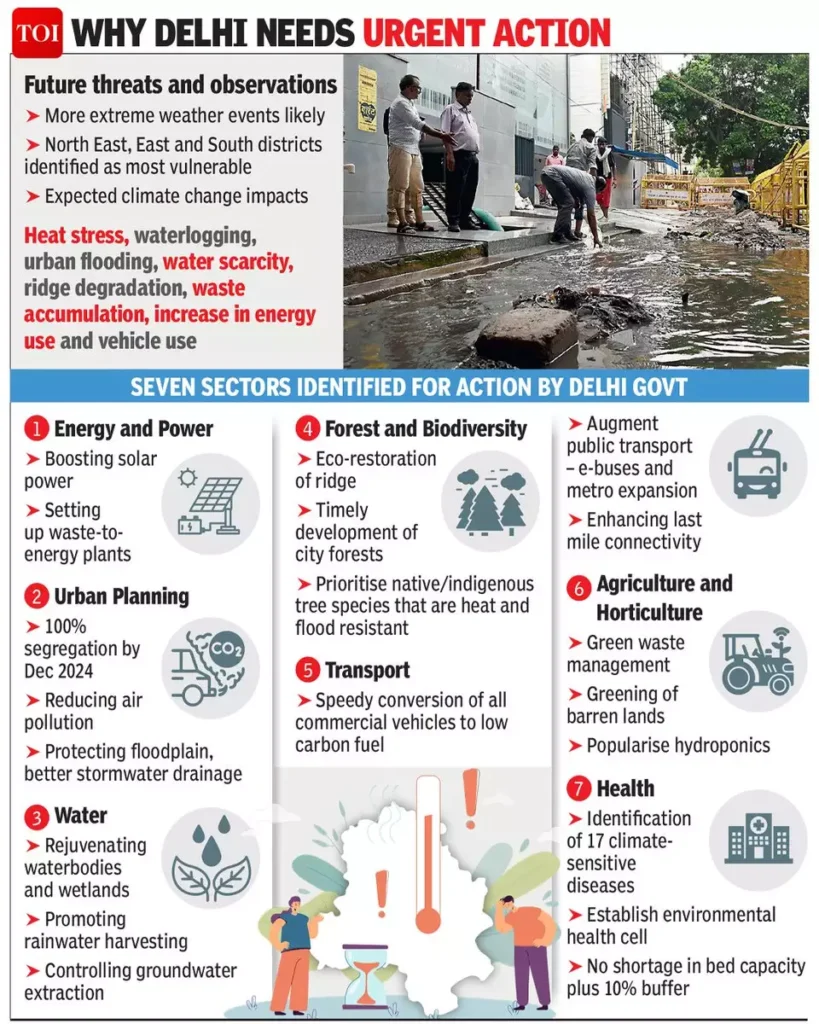The Delhi government is revising its State Action Plan on Climate Change (SAPCC), originally adopted in 2019 due to intensified extreme weather, including unprecedented heatwaves and record rainfall this year.
- The existing 2019 plan is deemed inadequate in addressing the recent surge in extreme weather events. Revised policies are needed to effectively combat and adapt to climate change impacts.
About State Action Plan on Climate Change (SAPCC):
- Purpose: States and Union Territories (UTs) develop SAPCCs to tackle climate change through adaptation and mitigation tailored to local conditions.
- Alignment: SAPCCs align with the National Action Plan on Climate Change (NAPCC), which provides a national framework for climate adaptation.
- NAPCC Overview: Released in 2008, NAPCC includes eight National Missions focusing on various aspects of climate change.
Funding and Status:
- Funding Source: Climate Change Action Plan scheme supports SAPCC implementation.
- Current Status: 34 States/UTs have prepared their SAPCCs.
Challenges in Implementation:
- Leadership and Political Will: A top-down approach and existing climate strategies limit effective implementation.
- Clear Actions: SAPCCs often lack specific and actionable details.
- Resource Constraints: States often rely on central government funding, which can be insufficient.
Way Forward:
- International Climate Finance: Potentially cover additional adaptation costs.
- Nodal Officers: Appoint officers in key departments to address institutional bottlenecks.
- Detailed Project Reports: Develop and regularly update project reports to ensure effective planning and execution.
Significance of State-Level Strategies:
- Just Transition: Example – Swaniti initiative in Jharkhand mobilized INR 45 Crores for renewable energy and sustainability projects.
- Decentralized Planning: Example – Carbon Neutral Meenangadi project in Kerala integrates climate action into local development.
- Conservation Efforts: Example – Mangrove cell of Maharashtra focuses on preserving mangroves and marine biodiversity.
Ref: Source
| UPSC IAS Preparation Resources | |
| Current Affairs Analysis | Topperspedia |
| GS Shots | Simply Explained |
| Daily Flash Cards | Daily Quiz |
Frequently Asked Question:
What is the purpose of the State Action Plan on Climate Change (SAPCC)?
States and Union Territories develop SAPCCs to tackle climate change through adaptation and mitigation tailored to local conditions.
How does the SAPCC align with the National Action Plan on Climate Change (NAPCC)?
SAPCCs align with the NAPCC, which provides a national framework for climate adaptation.
What is the funding source for SAPCC implementation?
The funding for SAPCC implementation comes from climate-related government initiatives.
When was the National Action Plan on Climate Change (NAPCC) released?
The NAPCC was released in 2008 and includes eight National Missions focusing on various aspects of climate change.
Why is the Delhi government considering revising the existing SAPCC?
The existing SAPCC is deemed inadequate in addressing the recent surge in extreme weather events, necessitating revised policies to effectively combat and adapt to climate change impacts.




